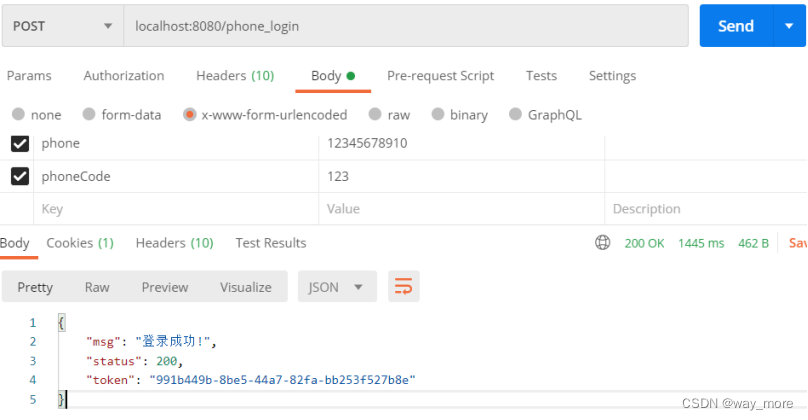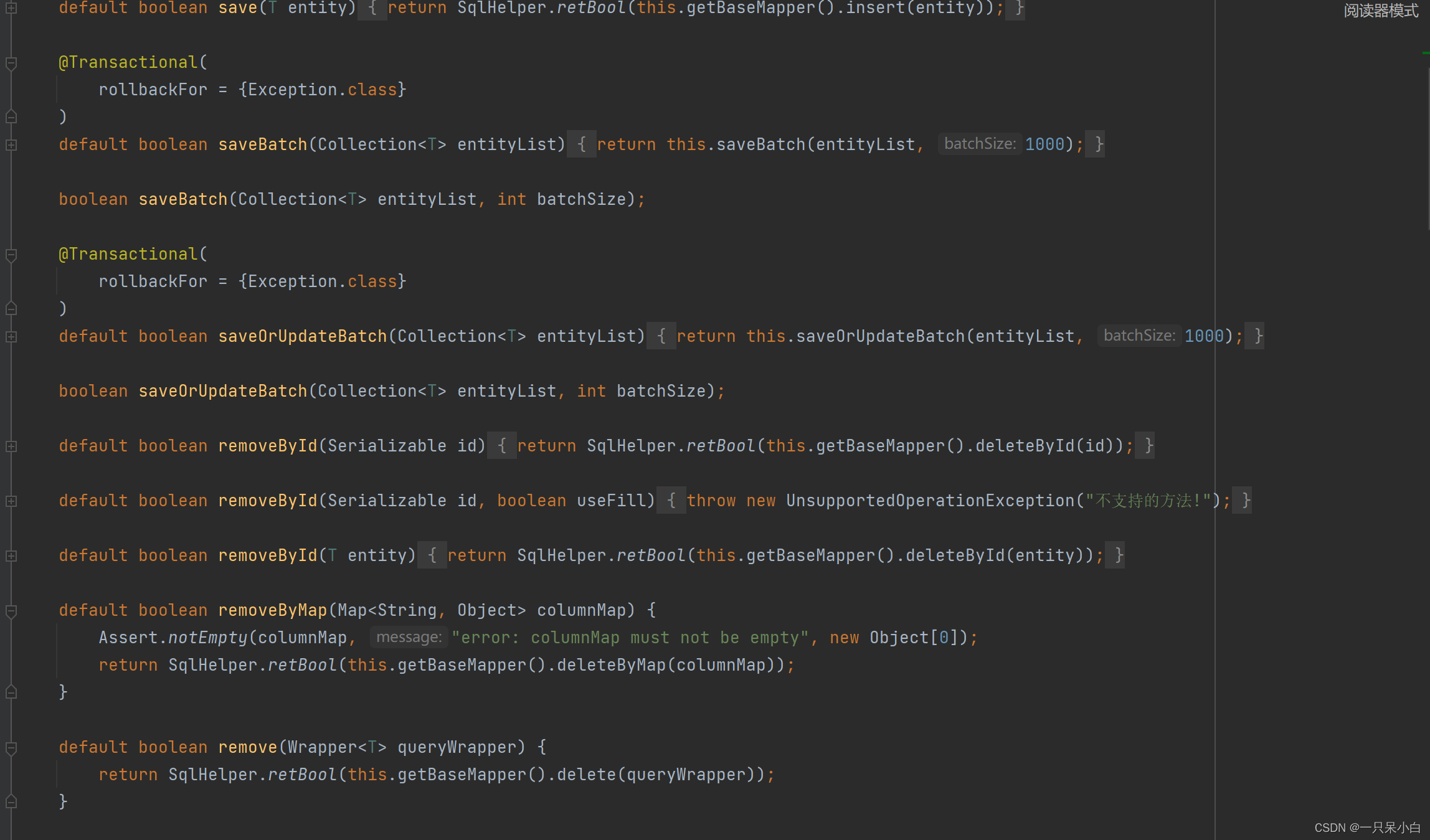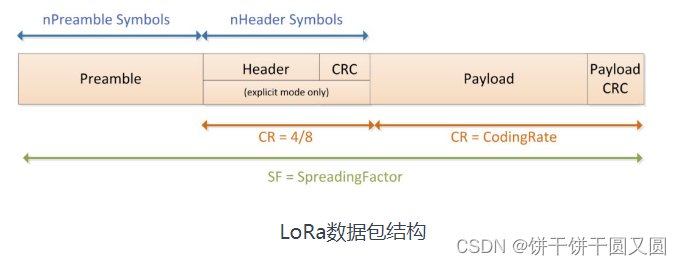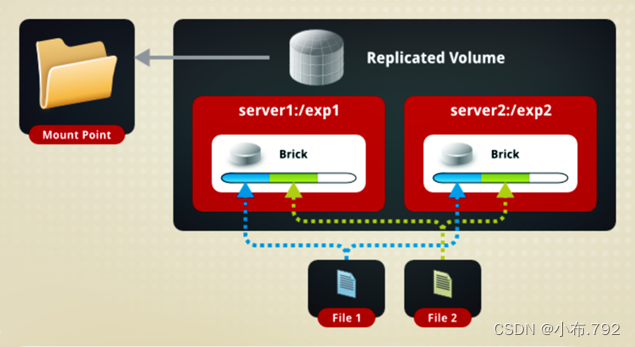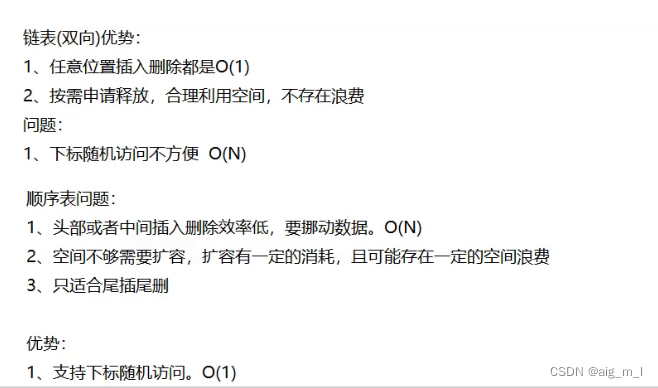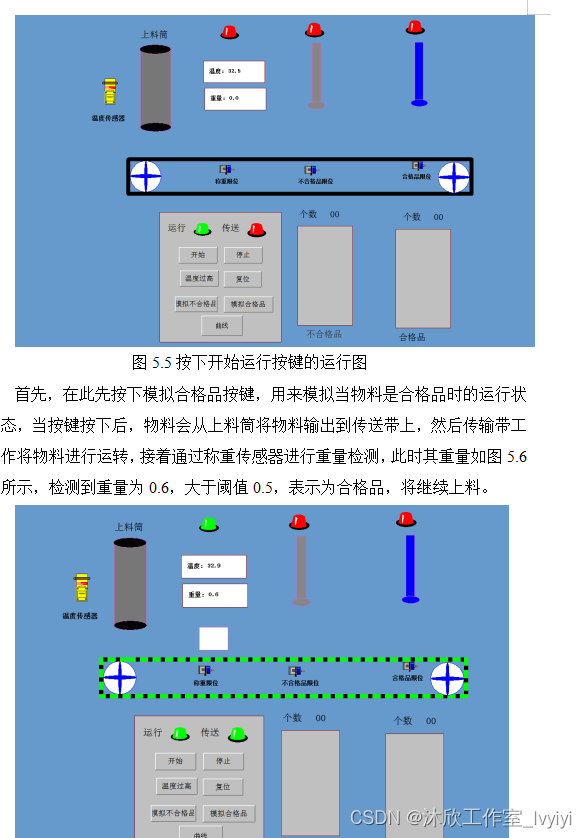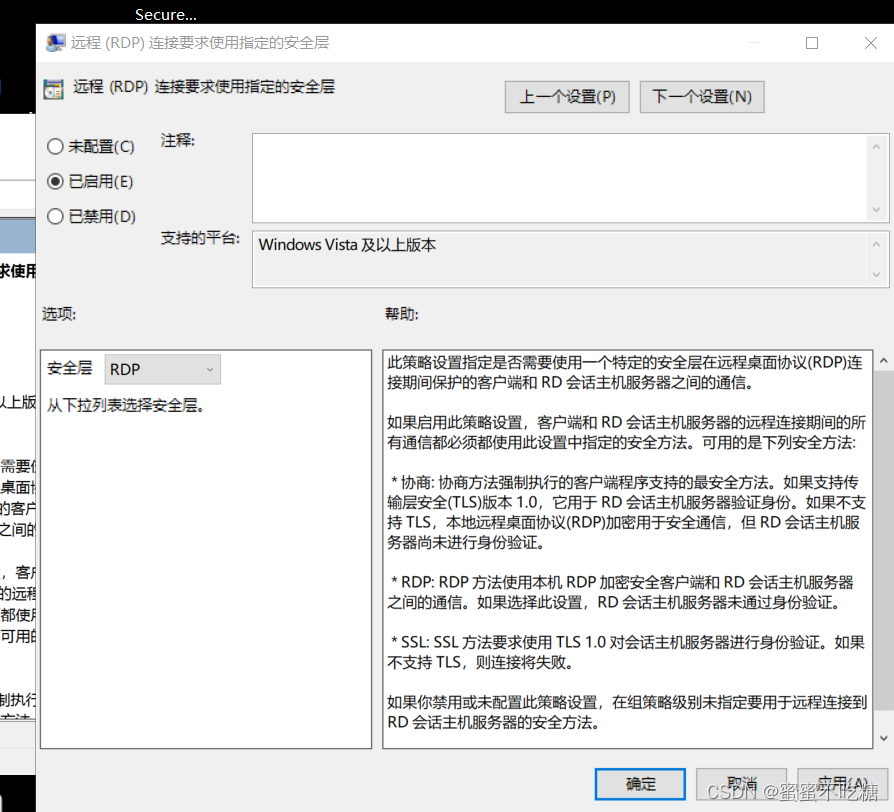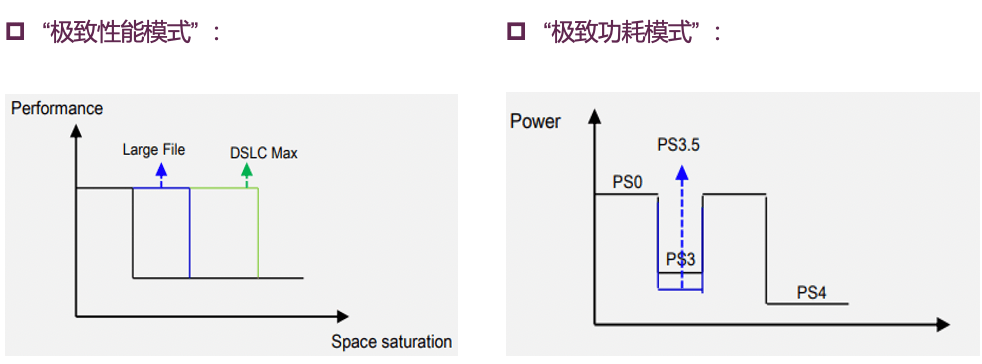目录
- 前言
- 1-自定义用户对象
- 2-自定义UserDetailsService
- 3-自定义Authentication
- 4-自定义AuthenticationProvider
- 5-自定义AbstractAuthenticationProcessingFilter
- 6-自定义认证成功和失败的处理类
- 7-修改配置类
- 8-测试
前言
现在登录方式越来越多,传统的账号密码登录已经不能满足我们的需求。可能我们还需要手机验证码登录,邮箱验证码登录,一键登录等。这时候就需要我们自定义我们系统的认证登录流程,下面,我就一步一步在SpringSecurity 自定义认证登录,以手机验证码登录为例
1-自定义用户对象
Spring Security 中定义了 UserDetails 接口来规范开发者自定义的用户对象,我们自定义对象直接实现这个接口,然后定义自己的对象属性即可
/**
* 自定义用户角色
*/
@Data
public class PhoneUserDetails implements UserDetails {
public static final String ACCOUNT_ACTIVE_STATUS = "ACTIVE";
public static final Integer NOT_EXPIRED = 0;
private String userId;
private String userName;
private String phone;
private String status;
private Integer isExpired;
@Override
public Collection<? extends GrantedAuthority> getAuthorities() {
Collection<GrantedAuthority> collection = new HashSet<>();
return collection;
}
@Override
public String getPassword() {
return null;
}
@Override
public String getUsername() {
return this.phone;
}
@Override
public boolean isAccountNonExpired() {
return NOT_EXPIRED.equals(isExpired);
}
@Override
public boolean isAccountNonLocked() {
return true;
}
@Override
public boolean isCredentialsNonExpired() {
return true;
}
@Override
public boolean isEnabled() {
return ACCOUNT_ACTIVE_STATUS.equals(status);
}
}
自定义角色实现UserDetails接口方法时,根据自己的需要来实现
2-自定义UserDetailsService
UserDetails是用来规范我们自定义用户对象,而负责提供用户数据源的接口是UserDetailsService,它提供了一个查询用户的方法,我们需要实现它来查询用户
@Service
public class PhoneUserDetailsService implements UserDetailsService {
public static final String USER_INFO_SUFFIX = "user:info:";
@Autowired
private PhoneUserMapper phoneUserMapper;
@Autowired
private RedisTemplate<String,Object> redisTemplate;
/**
* 查找用户
* @param username
* @return
* @throws UsernameNotFoundException
*/
@Override
public UserDetails loadUserByUsername(String username) throws UsernameNotFoundException {
//先查询缓存
String userKey = USER_INFO_SUFFIX + username;
PhoneUserDetails cacheUserInfo = (PhoneUserDetails) redisTemplate.opsForValue().get(userKey);
if (cacheUserInfo == null){
//缓存不存在,从数据库查找用户信息
PhoneUserDetails phoneUserDetails = phoneUserMapper.selectPhoneUserByPhone(username);
if (phoneUserDetails == null){
throw new UsernameNotFoundException("用户不存在");
}
//加入缓存
redisTemplate.opsForValue().set(userKey,phoneUserDetails);
return phoneUserDetails;
}
return cacheUserInfo;
}
}
3-自定义Authentication
在SpringSecurity认证过程中,最核心的对象为Authentication,这个对象用于在认证过程中存储主体的各种基本信息(例如:用户名,密码等等)和主体的权限信息(例如,接口权限)。
我们可以通过继承AbstractAuthenticationToken来自定义的Authentication对象,我们参考SpringSecurity自有的UsernamePasswordAuthenticationToken来实现自己的AbstractAuthenticationToken 实现类
@Getter
@Setter
public class PhoneAuthenticationToken extends AbstractAuthenticationToken {
private final Object principal;
private Object credentials;
/**
* 可以自定义属性
*/
private String phone;
/**
* 创建一个未认证的对象
* @param principal
* @param credentials
*/
public PhoneAuthenticationToken(Object principal, Object credentials) {
super(null);
this.principal = principal;
this.credentials = credentials;
setAuthenticated(false);
}
public PhoneAuthenticationToken(Collection<? extends GrantedAuthority> authorities, Object principal, Object credentials) {
super(authorities);
this.principal = principal;
this.credentials = credentials;
// 必须使用super,因为我们要重写
super.setAuthenticated(true);
}
/**
* 不能暴露Authenticated的设置方法,防止直接设置
* @param isAuthenticated
* @throws IllegalArgumentException
*/
@Override
public void setAuthenticated(boolean isAuthenticated) throws IllegalArgumentException {
Assert.isTrue(!isAuthenticated,
"Cannot set this token to trusted - use constructor which takes a GrantedAuthority list instead");
super.setAuthenticated(false);
}
/**
* 用户凭证,如密码
* @return
*/
@Override
public Object getCredentials() {
return credentials;
}
/**
* 被认证主体的身份,如果是用户名/密码登录,就是用户名
* @return
*/
@Override
public Object getPrincipal() {
return principal;
}
}
因为我们的验证码是有时效性的,所以eraseCredentials 方法也没必要重写了,无需擦除。主要是设置Authenticated属性,Authenticated属性代表是否已认证
4-自定义AuthenticationProvider
AuthenticationProvider对于Spring Security来说相当于是身份验证的入口。通过向AuthenticationProvider提供认证请求,我们可以得到认证结果,进而提供其他权限控制服务。
在Spring Security中,AuthenticationProvider是一个接口,其实现类需要覆盖authenticate(Authentication authentication)方法。当用户请求认证时,Authentication Provider就会尝试对用户提供的信息(Authentication对象里的信息)进行认证评估,并返回Authentication对象。通常一个provider对应一种认证方式,ProviderManager中可以包含多个AuthenticationProvider表示系统可以支持多种认证方式。
Spring Security定义了AuthenticationProvider 接口来规范我们的AuthenticationProvider 实现类,AuthenticationProvider 接口只有两个方法,源码如下
public interface AuthenticationProvider {
//身份认证
Authentication authenticate(Authentication authentication)
throws AuthenticationException;
//是否支持传入authentication类型的认证
boolean supports(Class<?> authentication);
}
下面自定义我们的AuthenticationProvider
/**
* 手机验证码认证授权提供者
*/
@Data
public class PhoneAuthenticationProvider implements AuthenticationProvider {
private RedisTemplate<String,Object> redisTemplate;
private PhoneUserDetailsService phoneUserDetailsService;
public static final String PHONE_CODE_SUFFIX = "phone:code:";
@Override
public Authentication authenticate(Authentication authentication) throws AuthenticationException {
//先将authentication转为我们自定义的Authentication对象
PhoneAuthenticationToken authenticationToken = (PhoneAuthenticationToken) authentication;
//获取手机号和验证码
String phone = authenticationToken.getPhone();
String code = (String) authenticationToken.getCredentials();
//查找手机用户信息,验证用户是否存在
UserDetails userDetails = phoneUserDetailsService.loadUserByUsername(phone);
if (userDetails == null){
throw new InternalAuthenticationServiceException("用户手机不存在!");
}
String codeKey = PHONE_CODE_SUFFIX+phone;
//手机用户存在,验证手机验证码是否正确
if (!redisTemplate.hasKey(codeKey)){
throw new InternalAuthenticationServiceException("验证码不存在或已失效!");
}
String realCode = (String) redisTemplate.opsForValue().get(codeKey);
if (StringUtils.isBlank(realCode) || !realCode.equals(code)){
throw new InternalAuthenticationServiceException("验证码错误!");
}
PhoneAuthenticationToken phoneAuthenticationToken = new PhoneAuthenticationToken(phone,code);
phoneAuthenticationToken.setPhone(phone);
//details是一个泛型属性,用于存储关于认证令牌的额外信息。其类型是 Object,所以你可以存储任何类型的数据。这个属性通常用于存储与认证相关的详细信息,比如用户的角色、IP地址、时间戳等。
phoneAuthenticationToken.setDetails(userDetails);
return phoneAuthenticationToken;
}
@Override
public boolean supports(Class<?> authentication) {
//isAssignableFrom方法如果比较类和被比较类类型相同,或者是其子类、实现类,返回true
return PhoneAuthenticationToken.class.isAssignableFrom(authentication);
}
}
5-自定义AbstractAuthenticationProcessingFilter
AbstractAuthenticationProcessingFilter是Spring Security中的一个重要的过滤器,用于处理用户的身份验证。它是一个抽象类,提供了一些基本的身份验证功能,可以被子类继承和扩展。该过滤器的主要作用是从请求中获取用户的身份认证信息,并将其传递给AuthenticationManager进行身份验证。如果身份验证成功,它将生成一个身份验证令牌,并将其传递给AuthenticationSuccessHandler进行处理。如果身份验证失败,它将生成一个身份验证异常,并将其传递给AuthenticationFailureHandler进行处理。AbstractAuthenticationProcessingFilter还提供了一些其他的方法,如setAuthenticationManager()、setAuthenticationSuccessHandler()、setAuthenticationFailureHandler()等,可以用于定制身份认证的处理方式。
我们需要自定义认证流程,那么就需要继承AbstractAuthenticationProcessingFilter这个抽象类
Spring Security 的UsernamePasswordAuthenticationFilter也是继承了AbstractAuthenticationProcessingFilter,我们可以参考实现自己的身份验证
public class PhoneVerificationCodeAuthenticationFilter extends AbstractAuthenticationProcessingFilter {
/**
* 参数名称
*/
public static final String USER_PHONE = "phone";
public static final String PHONE_CODE = "phoneCode";
private String userPhoneParameter = USER_PHONE;
private String phoneCodeParameter = PHONE_CODE;
/**
* 是否只支持post请求
*/
private boolean postOnly = true;
/**
* 通过构造函数,设置对哪些请求进行过滤,如下设置,则只有接口为 /phone_login,请求方式为 POST的请求才会进入逻辑
*/
public PhoneVerificationCodeAuthenticationFilter(){
super(new RegexRequestMatcher("/phone_login","POST"));
}
/**
* 认证方法
* @param request
* @param response
* @return
* @throws AuthenticationException
* @throws IOException
* @throws ServletException
*/
@Override
public Authentication attemptAuthentication(HttpServletRequest request, HttpServletResponse response) throws AuthenticationException, IOException, ServletException {
PhoneAuthenticationToken phoneAuthenticationToken;
//请求方法类型校验
if (this.postOnly && !request.getMethod().equals("POST")) {
throw new AuthenticationServiceException("Authentication method not supported: " + request.getMethod());
}
//如果不是json参数,从request获取参数
if (!request.getContentType().equals(MediaType.APPLICATION_JSON_UTF8_VALUE) && !request.getContentType().equals(MediaType.APPLICATION_JSON_VALUE)) {
String userPhone = request.getParameter(userPhoneParameter);
String phoneCode = request.getParameter(phoneCodeParameter);
phoneAuthenticationToken = new PhoneAuthenticationToken(userPhone,phoneCode);
}else {
//如果是json请求使用取参数逻辑,直接用map接收,也可以创建一个实体类接收
Map<String, String> loginData = new HashMap<>(2);
try {
loginData = JSONObject.parseObject(request.getInputStream(), Map.class);
} catch (IOException e) {
throw new InternalAuthenticationServiceException("请求参数异常");
}
// 获得请求参数
String userPhone = loginData.get(userPhoneParameter);
String phoneCode = loginData.get(phoneCodeParameter);
phoneAuthenticationToken = new PhoneAuthenticationToken(userPhone,phoneCode);
}
phoneAuthenticationToken.setDetails(authenticationDetailsSource.buildDetails(request));
return this.getAuthenticationManager().authenticate(phoneAuthenticationToken);
}
}
6-自定义认证成功和失败的处理类
pringSecurity处理成功和失败一般是进行页面跳转,但是在前后端分离的架构下,前后端的交互一般是通过json进行交互,不需要后端重定向或者跳转,只需要返回我们的登陆信息即可。
这就要实现我们的认证成功和失败处理类
认证成功接口:AuthenticationSuccessHandler,只有一个onAuthenticationSuccess认证成功处理方法
认证失败接口:AuthenticationFailureHandler,只有一个onAuthenticationFailure认证失败处理方法
我们实现相应接口,在方法中定义好我们的处理逻辑即可
@Component
public class CustomAuthenticationSuccessHandler implements AuthenticationSuccessHandler {
/**
* 登录成功处理
* @param httpServletRequest
* @param httpServletResponse
* @param authentication
* @throws IOException
* @throws ServletException
*/
@Override
public void onAuthenticationSuccess(HttpServletRequest httpServletRequest, HttpServletResponse httpServletResponse, Authentication authentication) throws IOException, ServletException {
httpServletResponse.setContentType("application/json;charset=utf-8");
Map<String, Object> resp = new HashMap<>();
resp.put("status", 200);
resp.put("msg", "登录成功!");
resp.put("token", new UUIDGenerator().next());
String s = JSONObject.toJSONString(resp);
httpServletResponse.getWriter().write(s);
}
}
@Slf4j
@Component
public class CustomAuthenticationFailureHandler implements AuthenticationFailureHandler {
/**
* 登录失败处理
* @param httpServletRequest
* @param httpServletResponse
* @param exception
* @throws IOException
* @throws ServletException
*/
@Override
public void onAuthenticationFailure(HttpServletRequest httpServletRequest, HttpServletResponse httpServletResponse, AuthenticationException exception) throws IOException, ServletException {
httpServletResponse.setContentType("application/json;charset=utf-8");
Map<String, Object> resp = new HashMap<>();
resp.put("status", 500);
resp.put("msg", "登录失败!" );
String s = JSONObject.toJSONString(resp);
log.error("登录异常:",exception);
httpServletResponse.getWriter().write(s);
}
}
7-修改配置类
想要应用自定义的 AuthenticationProvider 和 AbstractAuthenticationProcessingFilter,还需在WebSecurityConfigurerAdapter 配置类进行配置。
@Configuration
@EnableWebSecurity
public class SecurityConfig extends WebSecurityConfigurerAdapter {
@Autowired
private RedisTemplate<String, Object> redisTemplate;
@Autowired
private PhoneUserDetailsService phoneUserDetailsService;
@Override
protected void configure(HttpSecurity http) throws Exception {
http.authorizeRequests().anyRequest().authenticated()
.and()
.formLogin().successHandler(new CustomAuthenticationSuccessHandler()).permitAll()
.and()
.csrf().disable();
//添加自定义过滤器
PhoneVerificationCodeAuthenticationFilter phoneVerificationCodeAuthenticationFilter = new PhoneVerificationCodeAuthenticationFilter();
//设置过滤器认证成功和失败的处理类
phoneVerificationCodeAuthenticationFilter.setAuthenticationSuccessHandler(new CustomAuthenticationSuccessHandler());
phoneVerificationCodeAuthenticationFilter.setAuthenticationFailureHandler(new CustomAuthenticationFailureHandler());
//设置认证管理器
phoneVerificationCodeAuthenticationFilter.setAuthenticationManager(authenticationManager());
//addFilterBefore方法用于将自定义的过滤器添加到过滤器链中,并指定该过滤器在哪个已存在的过滤器之前执行
http.addFilterBefore(phoneVerificationCodeAuthenticationFilter, UsernamePasswordAuthenticationFilter.class);
}
@Bean
@Override
public AuthenticationManager authenticationManagerBean() throws Exception {
// 采用密码授权模式需要显式配置AuthenticationManager
return super.authenticationManagerBean();
}
/**
*
* @param auth 认证管理器
* @throws Exception
*/
@Override
protected void configure(AuthenticationManagerBuilder auth) throws Exception {
//添加自定义认证提供者
auth.authenticationProvider(phoneAuthenticationProvider());
}
/**
* 手机验证码登录的认证提供者
* @return
*/
@Bean
public PhoneAuthenticationProvider phoneAuthenticationProvider(){
PhoneAuthenticationProvider phoneAuthenticationProvider = new PhoneAuthenticationProvider();
phoneAuthenticationProvider.setRedisTemplate(redisTemplate);
phoneAuthenticationProvider.setPhoneUserDetailsService(phoneUserDetailsService);
return phoneAuthenticationProvider;
}
}
在Spring Security框架中,addFilterBefore方法用于将自定义的过滤器添加到过滤器链中,并指定该过滤器在哪个已存在的过滤器之前执行。还有一个addFilterAfter方法可以将自定义过滤器添加到指定过滤器之后执行。
8-测试
完成上面的操作之后,我们就可以测试下新的登录方式是否生效了。我这里直接使用postman进行登录请求
